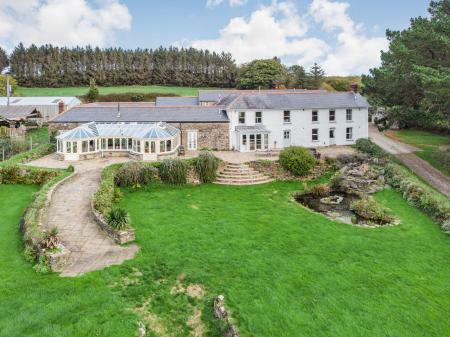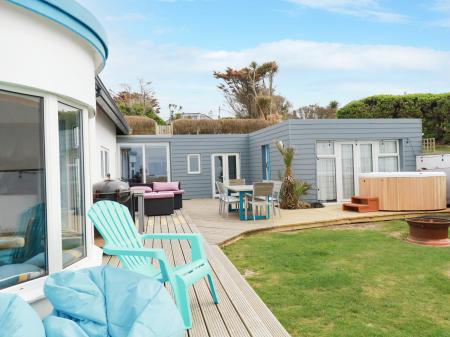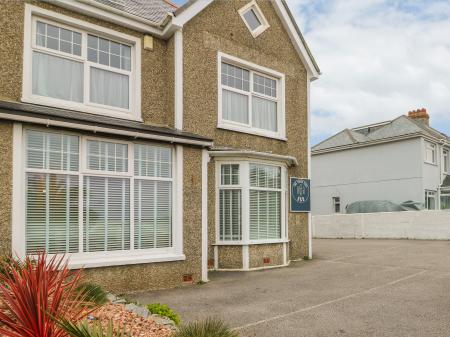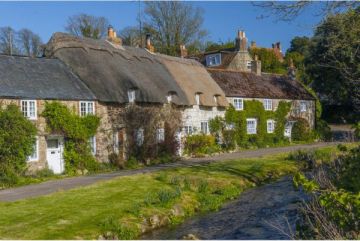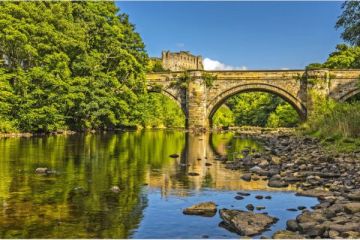Explore 25 of the best - and scariest - haunted historic houses and castles in England, places with a history of paranormal activity in a historic setting.
Who doesn't love a good ghost story? If you enjoy exploring England's historic houses and castles you'll run into a few spine-tingling tales. That's not surprising when you consider how long some of these historic buildings have been around. And those that still survive are often very atmospheric places, with creaking floorboards and dimly lit passages.
Whether you believe in ghosts or you just enjoy an atmospheric historic house or a medieval castle, these 25 haunted sites offer a little 'something extra' to visitors. Enjoy a visit ... if you dare!
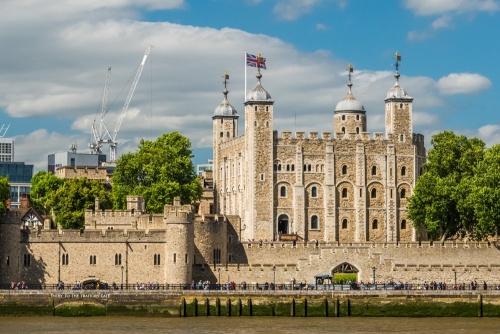
Is this the most haunted place in England? The Tower of London has been the subject of numerous paranormal investigations over the years, which is not surprising considering the number of murders and executions that have taken place here.
The ghost of the murdered king Henry VI is said to haunt Wakefield Tower. On the anniversary of his murder the king's spirit is said to pace back and forth in the tower until the clock strikes midnight.
The White Tower is home to a mysterious ghost known as the White Lady, who sometimes waves to groups of schoolchildren. The White Lady leaves behind a perfume so strong that has been known to make Tower guards ill.

For a house that was only begun in the Victorian period Woodchester Mansion has a lot of ghosts! In 1845 William Leigh purchased 400 acres of Cotswold parkland at Woodchester from Lord Ducie and set about creating a superb mansion on a lavish scale.
What prompted Lord Ducie to sell the large tract of land? After his father died Lord Ducie threw a lavish party at the family home of Spring Park to celebrate his inheritance. He came to take his seat only to find his dead father sitting there. He was so frightened that he left the house and never returned.
William Leigh called in architect AW Pugin to remodel Spring park but Pugin recommended tearing down the old house and building from scratch. Pugin and Leigh quarrelled and the house was designed by a pairing of Benjamin Bucknell and Charles Hansom, brother of Joseph Hansom, the inventor of the Hansom cab.
The shell of the house was built in exquisite Gothic Revival style, but then suddenly and mysteriously work stopped. Workmen simply lay down their tools and never returned, leaving Woodchester like a land-bound version of the Mary Celeste mystery. One version of the tale says that work stopped after a man was murdered on the site but it is more likely that Leigh's plans outstripped his bank account.
Perhaps it is this mysterious, unexplained end to the house's construction why so many ghosts have been sited at Woodchester. There is a spectral presence in the cellar, a Tall Man in the chapel, a ghostly old woman and a mysterious old woman. One visitor reported a floating head in the women's bathroom, and some visitors have reported being attacked by an unseen presence.

Possibly the most haunted castle in England, the ruined fortress of Berry Pomeroy dates to the late 15th century. The estate was owned by the Pomeroy family for over 400 years but in the 1540s it was seized by Edward Seymour, the powerful Lord Protector of England. It was around the time of Seymour's ownership that the medieval castle was transformed into a fortified Tudor mansion.
But those glory days did not last and by the middle of the 18th century Berry Pomeroy was a romantic ruin. A ruin, yes, but a terrifying one for some visitors, who have reported odd experiences like a bluish light at a castle window that is impossible to reach. Other visitors have reported that their cameras began to malfunction as they approached the castle and their car engines suddenly stalled.
Then there are the ghosts, like the spectre of the White Lady, said to be the ghost of Lady Margaret Pomeroy, who walks the battlements. Other ghostly figures include a woman dressed in blue and a large black dog. The Blue Lady haunts the castle tower while another White Lady haunts the castle dungeons.

Sir William Martyn built the picture-perfect manor house at Athelhampton about 1485. The medieval house was enlarged by Robert Martyn in the Tudor period. The result is perhaps the finest manor house in England.
The core of Athelhampton is the superb great hall, still boasting its original 15th-century roof and minstrel's gallery and the house retains its beautiful Tudor linenfold panelling.
Athelhampton is one of the most haunted houses in England. A pair of duelling ghosts are said to haunt the Great Chamber, while a spectral Grey Lady has been seen on several occasions around the grounds. A mysterious tapping noise has been heard in the wine cellar and several visitors have reported hearing the sound of cat feet on bare floorboards only to find they were alone.

Samlesbury Hall is one of the most picturesque timber-framed buildings in England, a magnificent 'black and white' house on the River Ribble dating to the 14th century. The house was remodelled in the 17th century but retains much of its medieval structure. In 1862 Samlesbury was purchased by Joseph Harrison, a close friend of author Charles Dickens, who stayed here several times.
Sadly, Harrison's lavish lifestyle led him into deep debt and he shot himself rather than face the consequences. You might think his ghost would haunt his former home, but you'd be wrong; the house is, instead, haunted by the ghost of Lady Dorothy Southworth, known as the White Lady of Samlesbury. Lady Dorothy (born circa 1525) fell in love with a young man whose family was Protestant.
Unfortunately, her own family were Catholic, so neither family would agree to the match. The couple made plans to elope, but Lady Dorothy's brother discovered the plan and ambushed the intended groom and his friend. He killed both of them and hid the bodies. Lady Dorothy was sent abroad to spend the rest of her life in a convent where she died. Her ghost haunts the hall at Samlesbury, waiting for her lover that never comes.
In a postscript to the tragic tale, centuries later workmen engaged in restoration work near the chapel discovered a pair of male skeletons. Could they be the bones of Lady Dorothy's lover and his friend?

This beautiful 17th-century house stands on the banks of the River Thames near Richmond. It is said to be haunted by the unquiet spirit of Elizabeth, Duchess of Lauderdale. The spendthrift Duchess was a leader of fashion and moved in the highest social circles of Restoration London. The Duchess was a woman of beauty, wit and charm - and boundless ambition.
She has been described as 'a violent friend, but a still more violent enemy'. She and her husband John Maitland, First Duke of Lauderdale, spent lavishly on Ham House, filling it with fine furniture, art, and richly coloured tapestries.
Sadly, she ended life in relative poverty and was forced to sell off her most prized possessions to pay her debts. One treasure, however, she refused to sell, and that was her beloved home.
The proud noblewoman's ghost is said to stalk her former home, particularly the Duchess's Bedchamber. Visitors to Ham House have reported hearing footsteps when there is no one there and catching a glimpse of a reflection on the Duchess's mirror. Some of the staff pause at the doorway and say, 'Good afternoon, your ladyship' before entering the room.
A former manager of Ham House was so concerned with unexplained events in the house that she called in an exorcist.

This beautiful late-medieval house was built in 1419 as a home for the Treasurer of York Minster. The house is built around a restored medieval great hall and boasts a wonderful collection of medieval and Georgian furnishings and fine art.
It also holds the Guinness Book of World Records title for having ‘Ghosts of the Greatest Longevity’.
When an engineer was installing central heating in the cellars of Treasurer's House he heard a sudden trumpet blast and saw to his amazement a troop of 20 Roman soldiers marching past.
To add to the spectacle their feet were lost to view beneath the floor level. Workmen later dug into the floor and discovered that Treasurer's House was built directly on top of the main Roman road into York. The road level was at the exact height that the soldiers' feet would have trod.
Another related story dates to the 1920s when a fancy dress party took place. One of the guests wandered into the cellar where she encountered a man dressed as a Roman legionnaire who put a spear across her path, stopping her from going further. She later discovered that none of the other guests was dressed as Roman soldiers.

Chartwell is a rambling house built from 1922 for Sir Winston Churchill on the site of a Tudor house. That 16th-century building was reputed to have hosted Henry VIII, who stayed at Chartwell while courting Anne Boleyn at nearby Hever Castle. You might suspect, then, that the ghost story at Chartwell would be an ancient one, but it is relatively recent and directly concerns Sir Winston himself.
In 1947 Churchill wrote an article entitled The Dream in which he told of seeing the ghost of his father Sir Randolph Churchill, sitting in his favourite armchair. He had a long conversation with his father's ghost and told him all that had happened since his death, including both world wars.
Sir Randolph listened with rapt attention to his son's story. He then struck a match to light a cigarette, and as the match struck, he disappeared, never to return.

This beautiful Jacobean stately home was built in 1616 by Sir Henry Hobart, who served as Chief Justice of the Court of Common Pleas under James I. Hobart's fashionable brick house was built on the ruins of an earlier Tudor house owned by the Boleyn family.
It seems highly likely that Anne Boleyn, the second wife of Henry VIII, was born at Blickling Hall sometime around 1501. Nothing is certain, however, and some historians believe that she was born at another Boleyn house in Kent.
Anne, of course, was beheaded by Henry on charges of treason. Her headless ghost is said to haunt her birthplace on the anniversary of her execution (19 May). Quite why the ghost has selected Blickling is a puzzle, for Anne was executed at the Tower of London.

A Norfolk neighbour of Blickling Hall is Felbrigg Hall, designed by Sir Robert Lyminge, the same architect responsible for Blickling. There was a medieval house at Felbrigg, owned by the Windham family.
In 1620 Thomas Windham, mindful of the fashionable new house erected by his neighbour Sir Henry Hobart at Blickling, rebuilt the earlier medieval; building in Jacobean style. The exterior is a mix of brick, stone, flint and plasterwork, but the interior is a magnificent mixture of fashionable elegance spanning the Jacobean, Georgian, and Victorian periods.
One beautiful room open to visitors is the library, with shelves stacked floor to ceiling with books. Many of these books were collected by William Windham III (1750-1810). He gained the moniker 'Fighting Windham' when he was sent down from Eton for his role in a school rebellion against an unpopular headmaster. A friend of Samuel Johnson of dictionary fame, Windham inherited some of Johnson's books at his friend's death. He collected more ... and more ... and more books. It is safe to say that Windham was obsessed with books.
He was visiting London in 1809 when a fire broke out in a friend's library. Windham could not bear to let his friend's precious books be lost to the flames and he risked his life to rescue them. He was badly injured in the attempt and succumbed to his injuries a few weeks later.
His ghost is seen in his beloved library at Felbrigg Hall, either sitting at the reading desk or relaxing in a leather armchair, surrounded by his books. His ghost is picky, though; it will only appear if a certain selection of his favourite books are on the table.

There has been a castle atop a high, conical hill in Dunster, on the fringe of Exmoor, since the 11th century. The first castle was built by William de Mohun, whose family held the castle until 1376 when they sold it to the Luttrell family. Since that time 21 generations of Luttrells have lived at Dunster Castle and the family still owns the castle today.
Though it began as a military stronghold, Dunster Castle was transformed into an opulent stately home in the Elizabethan period. It was transformed again in the Victorian period by architect Anthony Salvin, with elegant interiors and terraced gardens lush with semi-tropical plants.
With a history spanning almost 1000 years it is no surprise that Dunster Castle is linked to more than one ghost story. National Trust staff say that books mysteriously fall from the shelves by themselves, and the figure of a man in green walks that the stable area. More disturbing is the tale of an exceptionally tall skeleton found in the prison, with irons binding his wrists and ankles. Dogs will refuse to approach the place where the skeleton was discovered.

Nunnington Hall is a beautiful Elizabethan manor house beside the peaceful River Rye, on the edge of the North York Moors. The rambling Tudor house we see today was built by William Parr (1513 – 1571), the 1st Marquess of Northampton and the brother of Queen Katherine Parr, Henry VIII's sixth wife.
The ghost story that clings to this atmospheric house dates to the life of Lady Nunnington, the second wife of the Hall's owner. It seems that Lady Nunnington had her own son, and resented the fact that he stepson by her husband's first wife would inherit the estate. When her husband died she confined the boy to an attic room.
The only person allowed to see him was her own son, who brought the boy food and played with him. The older child escaped his prison and was never seen again. Lady Nunnington's own son pined for his playmate. He waited by the window for him to return. Tragically, he leaned too far, fell from the window and died.
Lady Nunnington was distraught with grief and roamed the halls, mourning for her son. When she died and the house was sold to new owners they reported seeing her ghost numerous times and hearing the sound of her skirts rustling on the stairs.

This stunningly atmospheric medieval fortress has its roots in the late Saxon period. In AD 975 Edward the Martyr, the young boy-king of Wessex, was murdered at the orders of his stepmother AElfrida to allow her own son Aethelraed ("the Unready") to take the throne. Centuries later King John kept political prisoners here, and he is said to have let 22 French knights starve to death in the dungeons.
In 1635 the castle was purchased by Sir John Bankes, Lord Chief Justice of England. Sir John spent most of his time in London and left the administration of the castle to his wife Lady Bankes. This indomitable woman defended the castle against two sieges by Parliamentary soldiers during the Civil War. She personally commanded the castle garrison and held out against her enemies for three years before she was betrayed by one of her own female supporters.
Even when Parliamentary troops captured the castle Lady Bankes fought on, locking herself in her private chambers and throwing hot coals on her attackers. The Parliamentary commander was so impressed with her courage that when she was finally overcome he allowed her to leave with her garrison and the castle keys.
So far it is a tale of courage and fortitude, but there's more. It seems that the woman who betrayed Lady Bankes and the castle garrison was filled with remorse. The headless body of the woman haunts the castle battlements accompanied by the sound of a child weeping.

Baddesley Clinton is a picturesque moated manor house in an idyllic rural setting. It has been described - with good reason - as 'the perfect late medieval manor house'. The manor dates to the 14th century but the timber-framed brick and stone house we see today was begun in the 14th century with alterations in 1630.
The beautifully decorated interiors are a delightful example of Tudor style, with exquisitely panelled rooms featuring beautifully carved Elizabethan overmantels. Those panels hide secrets, though; there are no less than three secret priest's holes, hiding places for Jesuit priests during the dark days of religious persecution in the 16th and 17th centuries.
The most memorable ghost story at Baddesley Clinton involves a religious figure, but it has nothing to do with priests in hiding. If you examine the floorboards near the library fireplace you will see a dark stain. This is said to be the blood of the minister of Baddesley Clinton Church, slain by Nicholas Broome, the owner of Baddesley Clinton in the late 15th century.
It seems that Broome, who inherited the estate in 1483, came home unexpectedly one day and discovered the minster being overly familiar with his wife. He slew the minister in a rage, and the man's blood made an indelible stain on the floorboards. It makes a good story, but unfortunately modern analysis of the bloodstain discovered that it was pig's blood.
There are, however, numerous reports of ghostly footsteps echoing down the dimly lit corridors of Baddesley Clinton.

Speke Hall, on the outskirts of Liverpool, is one of the most impressive timber-framed houses in England. It was begun by the Norris family in the 1530s on the site of an earlier medieval house. The Norris family were Catholic and they built a secret priest's hole so that visiting clerics could hide from religious persecution.
They built a peephole into a bedroom chimney to keep watch over the approach to the house entrance and added 'The Eavesdropper', a hole in the eaves above the front entrance where servants could listen to people waiting for admission to the house.
Sometime around 1755 Lady Mary Norris inherited Speke Hall. She married Lord Sidney Beauclerk, whose nickname 'Worthless' gives a strong hint as to his character. Lord Sidney promptly gambled away his wife's fortune.
When he informed Mary that they were ruined she threw their infant son out of the Tapestry Room window into the moat below. She then ran to the Great Hall and killed herself. Her distraught ghost is said to haunt the Tapestry Room to this day.
It makes a good story, but there's a flaw in the tale; Lady Mary actually outlived her husband, and their son lived until 1781.
It is possible, however, that the story is confused with an earlier tale from the Civil War period. It is said that when the Parliamentary army was approaching Speke Hall the lady of the house threw herself and her child out the window in an attempt to escape. They both died in the attempt rather than falling safely into the moat.
In any case, there have been reports of a lady in grey who haunts the Hall, drifting through walls and walking the corridors at night. The cradle in the Oak Bedroom has been said to rock mysteriously when there is no one there, as if propelled by an invisible hand.

This elegant Queen Anne house is located in Salisbury's fashionable Cathedral Close, looking across a wide green to the cathedral. The house was begun in 1701 by Thomas Mompesson and is arguably the best example of Queen Anne architecture in existence.
The original design may have been by Sir Christopher Wren but the house we see today was created by Charles Longueville in 1740. The house features an outstanding collection of Chippendale furniture.
The story of Mompesson House's ghost goes back to around 1660 and starts not at the house, and not in Salisbury but in Tidworth, where Thomas Mompesson’s cousin John Mompesson lived. Mompesson became annoyed at the noise made by a vagrant drummer in the street and had the man thrown in gaol and his drum seized. The bailiff, perhaps wondering what to do with the drum, gave it to Mompesson.
The drummer was charged with theft, but ominously proclaimed 'I have plagued him, and he shall never be quiet till he hath made me satisfaction for taking away my drum'. Mompesson and his family were plagued by the sound of nightly drumming, though no one was ever seen making noise. The family was distraught and unable to sleep. The 'Demon Drummer' became so noisy that a Royal Commission was appointed to investigate. The drummer was put on trial for witchcraft but was acquitted.
The family moved from Tidworth to Mompesson House in Salisbury, but they made the mistake of taking the drum with them and they continued to be plagued by the sound of nocturnal drumming.

The original Nottingham Castle was destroyed in the aftermath of the Civil War, leaving only sections of the outer walls and the castle gateway. Within the walls is a beautiful 17th-century mansion built by the Duke of Newcastle on the site of the medieval fortress. But it is what lies under the castle that gives rise to Nottingham Castle's most famous ghost story.
The castle - indeed much of Nottingham itself - is built over a labyrinth of ancient caves and tunnels. The hill on which the castle stands is honeycombed with underground passages.
It was through one of these passages that the teenage king of England, Edward III, crept on the night of 19 October 1330, accompanied by a band of supporters. The boy-king was engaged in a deadly bid to seize control of the throne from his mother Isabella of France and her lover, Roger Mortimer, who had ruled in his name since the murder of his father, Edward II.
Edward and his henchmen snuck into the castle in the dead of night through an unlocked tunnel. They fell upon Mortimer and his guards without warning, capturing Mortimer and killing the guards. Isabella fled in terror, to be found the next day in a woodshed, clad only in her nightgown. Mortimer was carted off to London where he was promptly executed for treason, and Isabella was banished from court life. Her ghost is said to wander the castle grounds, weeping and wringing her hands.

This magnificent historic house was built by Sir John Thynne in 1580 and stands in a magnificent parkland laid out by Capability Brown. The exterior reflects Longleat's Tudor roots but the interior has been remodelled in sumptuous Victorian style, much of it influenced by Italian art and architecture. At the heart of the house is the 16th-century hall and the Tudor long gallery still survives.
While many visitors come to Longleat to see the wide variety of family attractions on the estate, including the famous safari park, there is a more sinister side the house and its history.
In 1733 Thomas Thynne, 2nd Viscount Weymouth of Longleat married Lady Louisa Carteret, the daughter of Earl Granville. The Viscount suspected that his young wife was having an affair with a footman and either killed him in a duel or ordered him to be killed, depending on which version of events you prefer. He had the footman's body buried in the cellars.
Centuries later the body of a man wearing leather jackboots was unearthed in the cellar. The boots crumbled to dust as soon as they were exposed to air.
Lady Louisa died in 1736 after giving birth to her second child. Since then her spirit is said to haunt the passageway where her lover was killed, which has been dubbed 'The Green Lady's Walk'.

Chatsworth is one of the great stately homes of England, set in an idyllic Peak District landscape and surrounded by stunning historic gardens. The house is full to bursting with fine art, ceramics and sculpture.
In 1549 Sir William Cavendish purchased Chatsworth and the house is still in Cavendish hands over 450 years later. Sir William was married to the indomitable Lady Elizabeth Talbot, Countess of Shrewsbury, more popularly known to history as Bess of Hardwick.
More than anyone else Bess was responsible for creating Chatsworth as we see it today, and her ghost is said to still walk the corridors at night.

The stately home of Petworth House dates to the late 18th century but it replaces a much older medieval manor owned by the powerful Percy family. The medieval house was rebuilt several times in the 17th and 18th centuries but the core of the house we see today was built by Charles, Duke of Somerset, who nickname 'The Proud Duke' tells you all you need to know about his character.
Petworth is known for its remarkable collection of fine art, including paintings by JMW Turner, Thomas Gainsborough, and Sir Joshua Reynolds.
The 2nd Earl of Chesterfield owned Petworth from 1632-1668. Whilst on a trip to London the Earl had a frightening experience of seeing a ghostly figure in white appear beside his bed.
He dismissed the experience as a bad dream, but when he returned home to Petworth his wife told him that she had seen the very same ghostly figure the night before. No one knows who the figure was or why it appeared to both the Earl and Countess separately.

Crook Hall is a wonderfully quirky 13th-century manor house on the edge of Durham. Though the house was added to and remodelled in the Jacobean period the hall and screens passage survive from that first medieval building.
A set of stairs rise from the screens passage to the ceiling, where they suddenly stop. A ghostly 'White Lady' is said to glide down this set of stairs on St Thomas' Eve each year (20 December).
In the medieval hall is a large fireplace under a minstrel's gallery. At the other end of the hall is a trestle table and on one side of the table is a small round-headed niche set into the end wall.
Ghostly legends cling to this area; one story says that a medieval soldier was murdered here in a fight over a woman, and some guests report a peculiar cold breeze when standing in the niche.

As a gesture of thanks by a grateful nation Blenheim Palace takes some beating. Blenheim - the only non-royal residence in Britain to be dubbed a palace - was built for Sir John Churchill, the victor of the Battle of Blenheim. It helped that Churchill's wife Sarah was Queen Anne's closest friend and confidente at the time. The architect was Sir John Vanbrugh, who also designed Castle Howard in Yorkshire.
At Blenheim he created an extraordinary complex of buildings meant to awe and impress visitors, a function they still fulfil centuries later.
The Palace stands amidst parkland laid out by Capability Brown several decades later. A descendant of Sir Jon Churchill was another popular leader - Sir Winston Churchill, who was born at Blenheim Palace in a small room just off the Palace entrance.
Some visitors to Blenheim have reported seeing a Civil War soldier huddled by a fireplace in one of the bedrooms, even though the house was not built until long after the war had ended. Other visitors report a spectral clergyman appearing in the Dean Jones room.

This beautiful stately home has been the family residence of the Sitwells for over 350 years. It was begun in 1625 as a small manor house, but in 1800 the head of the household, the wonderfully-named Sitwell Sitwell, transformed the earlier building into an elegant Georgian stately home set in 300 acres of stunning parkland.
The house stands in award-winning formal gardens created in 1895 by Sir George Sitwell, including fountains, topiary hedges, and Gothic follies. The house itself is a delightfully eccentric mixture of period furniture, fine art, and oddities collected by the Sitwells over hundreds of years.
Visitors to Renishaw Hall have reported odd experiences such as seeing an odd elderly servant literally drifting along dimly lit corridors. Guests staying overnight report being awakened by cold kisses when there was no one there.

The elegant mansion of Lyme Park dates to the Tudor period but was transformed into an opulent Palladian residence by Peter Legh from 1725. The Georgian mansion incorporates an Elizabethan long gallery from the previous Legh residence on this site.
This astonishing showpiece home is filled with fine tapestries, carvings by Grinling Gibbons, and a collection of historic English clocks. The house stands amid beautiful Victorian gardens including a sunken garden and a Gothic hunting tower.
The Legh family had a tradition of naming their male heirs Peter or Piers, many of whom had distinguished military careers. One of them was Sir Piers Legh II, who fought at Agincourt in 1415. He was fatally injured in a later battle against the French in 1422.
Visitors to Lyme Park have reported seeing his funeral procession pass through the grounds, accompanied by the sorrowful weeping of his mistress, Blanche.

We've saved arguably the best for last. Chillingham Castle bills itself as the most haunted house in England. The castle dates to the 13th century and has been in the hands of the Grey family since 1246.
The Castle retains its original Great Hall with its minstrel's gallery and the bedroom where Edward I stayed in 1298 on his way to do battle with William Wallace. The castle is remarkably unaltered since the 13th century barring the addition of galleries built to welcome James VI of Scotland on his way south to be crowned king of England in 1604. The castle stands in superb 18th-century gardens laid out by Capability Brown.
Visitors to Chillingham have reported a host of strange experiences over the years. Among the most frequent reports is sensing a presence when there is no one there. A mysterious White Lady has been seen in the Inner Pantry and voices can be heard in the chapel when there is no one around.
Chillingham was used as a place of execution over the centuries and the spirits of 8 executed prisoners are said to haunt the place they died. Other paranormal phenomena include a ghostly royal procession, a mysterious blue boy, a ghost named Lady Mary and the spirit of a tortured child.
There undoubtedly other historic houses and castles with a ghostly tale to tell, but these 25 places have a history of something a little out of the ordinary. Visit if you dare!
MOST POPULAR POSTS
